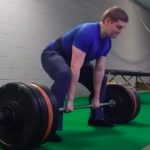
By Elliot Fisher MS, ATC, CSCS, PES
Often my clients will ask if their form looks good on an exercise or if they are doing an exercise correctly. Most of the time their technique is good and they have nothing to worry about. Sometimes though, clients do have some issues that need to be addressed.
The concept of perfect form is a misnomer. Different coaches have different preferences on exercise technique. For example, in Starting Strength by strength coach Mark Rippetoe, he recommends having the toes pointed out (maybe about 45 degrees of external rotation) during the squat.1 In Becoming a Supple Leopard, Dr. Kelly Starrett recommends squatting with feet straight forward.2 Finally, in the NSCA’s textbook Essentials of Strength Training and Conditioning, it is recommended to squat with feet slightly external rotated about 10 degrees.3 These are three great references for exercise technique, however they all differ. None of them are right or wrong, it is simply how they teach the exercise based on their experiences.
When looking at exercise technique there are some considerations that need to be made, because while perfect from may not be a thing, poor form is definitely real. The three considerations are:
- Injury Prevention
- Objectivity or consistency of the lift
- Efficiency
Injury Prevention
There are certain things that can go wrong when exercising. If you put your body into a bad position it can lead to further wear and tear on the tissues or increase the risk of an acute injury. An example could include spinal flexion (back rounding) on the deadlift or squat. When the spine is loaded and in a flexed position it can increase the risk of disk herniation, which can be a devastating injury. In this case, it is important for good technique on the deadlift or squat to maintain a neutral and stable spine.
Objectivity and Consistency
When I teach clients the squat, I always emphasize going deep, at least to the point where the femurs are parallel with the ground. The reason for this is for objectivity and consistency. If I did not set a baseline for depth on the exercise, then as the weight gets heavier my clients would most likely start to cut depth. The same goes in the research setting and in competition. In research, consistency is important. It would be a problem if there was a study done on the squat and half of the people reached 120 degrees of knee flexion, while the other half only hit 90 degrees of knee flexion. This inconsistency would become a confounder in the research, making specific technique important. In competition, USAPL powerlifting for example, the crease of the hips must be at or below the top of the knee in order to count as a rep. This is done as a form of consistency so competitors aren’t getting away with less than others.
Efficiency
Finally, it is important for an exercise to be efficient if your goal is to maximize performance. Let’s use the squat as an example. In the squat, it is common for people to have excessive forward lean, causing the bar to come over their toes, slightly in front of the center of balance. This causes the bar to start at the top and when it comes down on the decent it also moves forward, in a diagonal direction. It is recommended by many coaches to try to keep the chest up so that when you squat down the bar stays over the middle of the foot and goes up and down in a straight line. The difference between these two squats is minimal but significant. The squat that has a straight bar path rather than a slightly diagonal bar path will have a couple of centimeters less distance of travel. This means you are working harder on the diagonal bar path than the straight bar path. To illustrate this, think about walking from one side of the room to another. If you go straight from one side to the other, it will be a shorter distance than walking in a zigzag pattern. Efficiency may not be as important for people who do not compete in any sport, but it is very important when the person is an athlete and needs to maximize their performance.
Conclusion
There is no such thing as perfect form for exercise, as there are a lot of possibilities at what can constitute good technique. However, poor technique is a real thing. When looking at your exercise technique make sure you are not doing anything dangerous, make sure you are consistent with your exercise technique, and finally try to be as efficient as possible with your exercises if performance is a goal.
References
- Rippetoe M. Starting Strengh Basic Barbell Training. 3rd Edition. Wichita Falls, TX: The Aasgaard Company; 2013.
- Starrett K. Becoming a Supple Leopard. 2nd Edition. Las Vegas, NV: Victory Belt Publishing Inc; 2015.
- Haff, G. G., & Triplett, N. T. (Eds.). (2015). Essentials of Strength Training and Conditioning 4th Edition. Human kinetics.
Comments are closed.